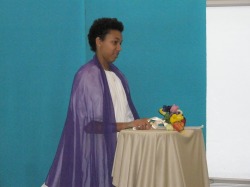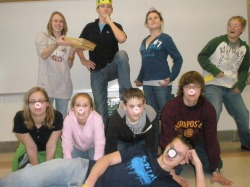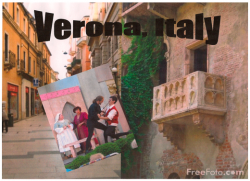Literary Analysis

MISSING SCENES (ROMEO & JULIET)
After reading Romeo and Juliet, students brainstorm a list of possible missing scenes-- scenes that fit between what we see on the stage. After selecting one, each student writes his/her scene, as a play, fluidly fitting it into what they know about the characters, plot and setting that Shakespeare created. Their scenes range from versions of how Romeo and Rosaline met to the conversation Lady Capulet and her husband had after he yelled at Juliet, giving her an ultimatum of marrying Paris. This kind of literary analysis creates an opportunity to evaluate and analyze characters in a different way. Students still have to consider motivations and character flaws, but in order to weave them into their scenes fluidly, they must understand the characters they use.
After writing their scenes, their small groups select one to perform for the class, complete with costumes and props. Because of the creativity in their ideas, they are excited to share what they have written with others.
To see examples of the missing scenes from the 2009 group of English 1 students, follow these links:
Missing scene 1
Missing scene 2
Missing scene 3
Missing scene 4
Missing scene 5
After reading Romeo and Juliet, students brainstorm a list of possible missing scenes-- scenes that fit between what we see on the stage. After selecting one, each student writes his/her scene, as a play, fluidly fitting it into what they know about the characters, plot and setting that Shakespeare created. Their scenes range from versions of how Romeo and Rosaline met to the conversation Lady Capulet and her husband had after he yelled at Juliet, giving her an ultimatum of marrying Paris. This kind of literary analysis creates an opportunity to evaluate and analyze characters in a different way. Students still have to consider motivations and character flaws, but in order to weave them into their scenes fluidly, they must understand the characters they use.
After writing their scenes, their small groups select one to perform for the class, complete with costumes and props. Because of the creativity in their ideas, they are excited to share what they have written with others.
To see examples of the missing scenes from the 2009 group of English 1 students, follow these links:
Missing scene 1
Missing scene 2
Missing scene 3
Missing scene 4
Missing scene 5
| the_missing_scene.pdf |
LITERARY LETTER (THE CRUCIBLE)
Students write a letter to Abigail as Elizabeth. Students trade papers and respond to the letter, in the character of Abigail. Students will then underline the most powerful line from each letter. In groups of 5-6, students will organize those lines to form a poem that will essentially be a character analysis. Modeling this with one group in front of the glass will really help kids to see the process as well as the fun they can have with the activity.
This activity can be adapted to fit any text. I have also used this with Kate Chopin's "Desiree's Baby".
| literary_letter_.pdf |
NON-FICTION ANALYSIS
Students generally feel literary analysis is just looking for the symbols; however, using non-fiction for analysis can really get students reading deeply into a text. Also, I recommend my students have at least 3 different colors of pens handy when they read. I ask students to use one color for the first read, a different color for the second and so on. By doing this, the students can really see how much more there is to a text than what they see the first time through.
Below are some samples of effective non-fiction texts that kids really enjoy as well as a multi-colored reading of each.
| dillard_-_the_chase_text-1.pdf |
| multi-colored_reading_of_the_chase.pdf |
| multi-colored_reading_of_shame.pdf |
| multi-colored_reading_of_shame.pdf |
| multi-colored_reading_of_salvation.pdf |

CHARACTERS TALK BACK
After reading a series of texts, including some contemporary and some more classical, students create a script that involves at least three of the characters from three separate pieces (and historical periods) having a conversation about the essential question for the thematic unit of study. This is a great opportunity for students to practice dialogue, if they write in narrative form; students could also write as a drama, with stage directions and character cues; for a creative twist, students could perform the drama, either in rehearsed fashion, or as a hot-seat drama, with roles assigned just shortly before the performance and the audience acting as a talk-show audience, with time to ask the panel questions. This kind of composition requires students to analyze the texts they have read, make inferences about the characters, and put those inferences into action. The analysis required here is far deeper than a traditional 5-paragraph essay and students enjoy the creativity of the analysis.
After reading a series of texts, including some contemporary and some more classical, students create a script that involves at least three of the characters from three separate pieces (and historical periods) having a conversation about the essential question for the thematic unit of study. This is a great opportunity for students to practice dialogue, if they write in narrative form; students could also write as a drama, with stage directions and character cues; for a creative twist, students could perform the drama, either in rehearsed fashion, or as a hot-seat drama, with roles assigned just shortly before the performance and the audience acting as a talk-show audience, with time to ask the panel questions. This kind of composition requires students to analyze the texts they have read, make inferences about the characters, and put those inferences into action. The analysis required here is far deeper than a traditional 5-paragraph essay and students enjoy the creativity of the analysis.

LITERARY POSTCARD (ROMEO & JULIET, THE ODYSSEY, TANGERINE)
For this writing piece, students are instructed to create a postcard of a scene, right after reading, in order to assess whether they understood the reading. The front of the postcard illustrates the scene and the back is a note, postcard style, to a friend at home, describing the scene's events from the perspective of an on-looker. Students enjoy viewing their peers' creations and it allows for an interesting discussion about what each person focused on.
For this writing piece, students are instructed to create a postcard of a scene, right after reading, in order to assess whether they understood the reading. The front of the postcard illustrates the scene and the back is a note, postcard style, to a friend at home, describing the scene's events from the perspective of an on-looker. Students enjoy viewing their peers' creations and it allows for an interesting discussion about what each person focused on.
| postcard_assignment.pdf |
BOOK REVIEW WIKI
Using wikispaces free-for-educators wiki (a collaborative space on the internet to write), several classes at our middle schools have created a book search wiki, full of book reviews written by students. The space is organized by genre, and when students are finished with an independent reading book, they publish a book review with a password-protected login. If they are looking for a good book recommendation, they peruse the entries. This kind of student publication is powerful since students are writing for a real audience! Not every entry is well-edited, but each entry is real student writing.
Click here to view the Baldwin Books Wiki.
Using wikispaces free-for-educators wiki (a collaborative space on the internet to write), several classes at our middle schools have created a book search wiki, full of book reviews written by students. The space is organized by genre, and when students are finished with an independent reading book, they publish a book review with a password-protected login. If they are looking for a good book recommendation, they peruse the entries. This kind of student publication is powerful since students are writing for a real audience! Not every entry is well-edited, but each entry is real student writing.
Click here to view the Baldwin Books Wiki.
| wiki_assignment.pdf |
ONE WORD POETRY ANALYSIS
After reading through a poem, ask students to identify the ONE WORD that the whole poem hinges on-- just one word. I make them box it in on the copy of the poem. Then, go around the room, asking each student to say ONLY that one word. This gives the other students a glimpse at what others think. Once you have heard everyone's words, then begin to discuss why-- why this word? What about this word was most important? While they are discussing, you will be amazed at how much better they understand the poem-- and how deep the discussion can be just based on ONE WORD. (Plus, every student can commit to one word-- it doesn't take much to get them to participate in this one since they are only committing to one word.)
After reading through a poem, ask students to identify the ONE WORD that the whole poem hinges on-- just one word. I make them box it in on the copy of the poem. Then, go around the room, asking each student to say ONLY that one word. This gives the other students a glimpse at what others think. Once you have heard everyone's words, then begin to discuss why-- why this word? What about this word was most important? While they are discussing, you will be amazed at how much better they understand the poem-- and how deep the discussion can be just based on ONE WORD. (Plus, every student can commit to one word-- it doesn't take much to get them to participate in this one since they are only committing to one word.)
WHO'S TO BLAME?
After your students have completed the reading of a literary text with characters, make a list of those characters, plus a few "other" lines. Ask them to identify who is to blame for the situation at hand. For example, in "The Cask of Amontillado," the list might look like this:
___Fortunado
___Montressor
___Servants
___Other
Then, when students have the list, ask them to assign percentages to each character-- how much to blame is each character? The total must add up to 100%.
Then, once they have ranked and added, discuss-- this is a great tool for the end discussion for heavy works like Romeo and Juliet. I have also used it for other YA fiction like Tangerine by Edward Bloor or Stargirl by Jerry Spinelli. As students discuss their rankings, they are making inferences about the motivations of characters and the ideas that are presented in the book-- whether they know this or not. It's a great way to lead into a literary analysis paper, in which they have to examine the same idea, or a related topic.
After your students have completed the reading of a literary text with characters, make a list of those characters, plus a few "other" lines. Ask them to identify who is to blame for the situation at hand. For example, in "The Cask of Amontillado," the list might look like this:
___Fortunado
___Montressor
___Servants
___Other
Then, when students have the list, ask them to assign percentages to each character-- how much to blame is each character? The total must add up to 100%.
Then, once they have ranked and added, discuss-- this is a great tool for the end discussion for heavy works like Romeo and Juliet. I have also used it for other YA fiction like Tangerine by Edward Bloor or Stargirl by Jerry Spinelli. As students discuss their rankings, they are making inferences about the motivations of characters and the ideas that are presented in the book-- whether they know this or not. It's a great way to lead into a literary analysis paper, in which they have to examine the same idea, or a related topic.

CHARACTER MENU
For this end-of-book assignment, students are asked to create a menu that reflects of symbolizes a cast of characters or one particular character. Rather than a boring character analysis, this lively, engaging culmination results in high-level thinking and comparing, references back to the text, and a food day!
(Stay tuned for the assignment pages associated with this)
For this end-of-book assignment, students are asked to create a menu that reflects of symbolizes a cast of characters or one particular character. Rather than a boring character analysis, this lively, engaging culmination results in high-level thinking and comparing, references back to the text, and a food day!
(Stay tuned for the assignment pages associated with this)
